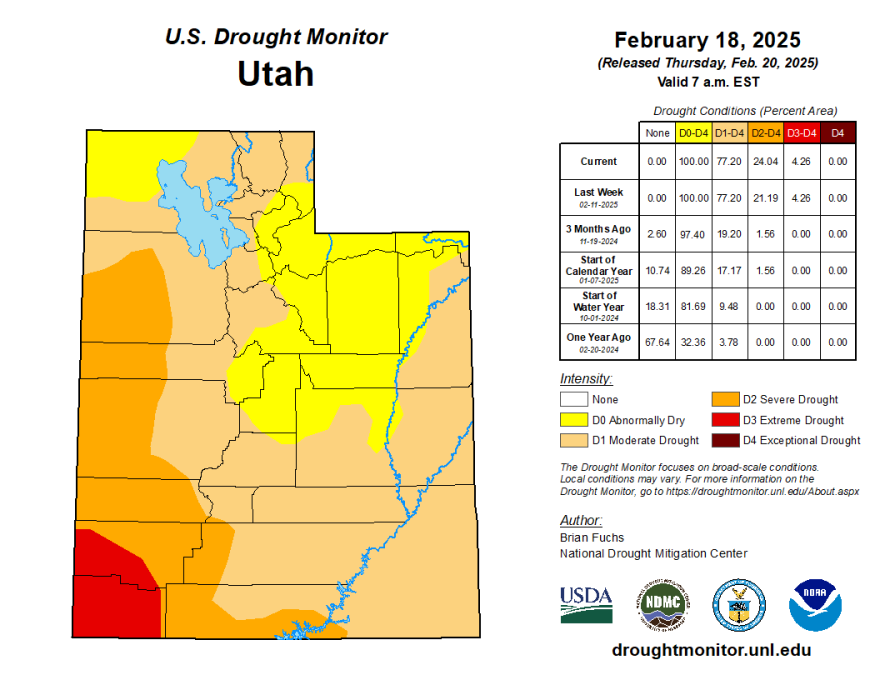After two relatively wet years in Utah, drought has returned in a big way.
More than 77% of the state is currently in drought. That’s up from 21% a few weeks ago, and it represents the worst conditions Utah has seen in nearly two years.
Even the parts of Utah that aren’t in drought are still listed as abnormally dry in the U.S. Drought Monitor’s latest report. And the latest Climate Prediction Center forecast predicts those areas will be in drought by spring.
Because Utah hasn’t had drought alarms going off for a while, state water leaders want to make sure people haven’t forgotten about the importance of conservation — something they have been cautioning against for months.
“It is a little bit tricky when you have a couple of good years and you're feeling good about water supply to then, all of a sudden, have a situation where you're not as well off,” said Utah Division of Water Resources Director Candice Hasenyager.
That’s why the state wants to move its messaging away from temporary warnings each time drought hits to a year-round mindset of conservation.
“Whether it's wet or dry, we always need to be using our water wisely,” she said. “Obviously, when we enter into extreme drought conditions, it becomes even more apparent.”

Right now, those conditions are most dire in southwest Utah, where the drought is the worst it has been since July 2022.
Nearly all of Washington County is in extreme drought, the second-highest level on the Drought Monitor’s scale. That’s no surprise to Washington County Water Conservancy District General Manager Zach Renstrom, though.
“We live in a desert, and we knew it was just a matter of time before we had another drought,” he said.
It’s something he and other southwest Utah water managers have been preparing for. Even though the St. George area faces possibly “one of the worst water years in recorded history,” Renstrom said the area will “have safe, reliable drinking water this summer.”
He credits that to recent efforts to ramp up conservation, such as restrictions on how much grass can go around new development and the rebate program that pays people to remove their irrigated lawns. Both have helped reservoirs to stay at healthy levels for now, he said.
Still, with additional growth in the county’s future, leaders are doing more to prepare — from ramping up wastewater recycling to building new reservoirs.
The district is also working with local governments to finalize and adopt a drought contingency plan by the end of the year. The draft proposal features five stages — labeled as zero through four — based on environmental conditions, such as reservoir levels, snowpack and the water demand in the community. Each stage triggers an escalating response as conditions worsen.
Washington County is currently in stage one, “but this summer, if we don't get anything — like, if we don't get any precipitation for the rest of the spring — we'll easily probably drop into phase two,” Renstrom said. “And then if we have another horrible year, we could go into phase three next year.”
Based on the proposal, stage two would include penalties for high water users, a pause on the planting of new grass and a ban on running water features and misting systems. Stage three could add new regulations on building permits, cut water use at golf courses and make hand-watering of trees the only type of landscape irrigation allowed.
District data shows the county has only hit stage two conditions for 9% of the time over the past three decades. It reached stage three just once, in 1996.
Despite the recent wet years, Hasenyager has seen a positive change in the way Utahns stay aware of drought since the last serious dry spell a few years ago. Still, communicating water issues in ways that the public can readily grasp isn’t always easy, she said.

First, water numbers can be awkward, so the state tries to make them more tangible. Rather than throwing out a statistic about thousands of acre-feet, for instance, it might compare a large amount of water to the size of a local reservoir people know. Also, Utah is a big state, so water conditions and solutions vary widely. Some conservation efforts, such as wastewater reuse, might work well in St. George but not for return flows into the Great Salt Lake.
With drought and water supplies a consistent issue, she said message fatigue is also a concern. So, the state is “trying to look at different angles to try to communicate not only how people use water but ways in which they can reduce water use.”
There’s still more work to do when it comes to making sure the public understands this issue. For example, she said surveys show Utahns generally understand that outdoor watering is a bigger use than indoor water use, but most people underestimate just how big outdoor watering is.
“Most of our water is used outdoors, and that's where the real opportunity is,” Hasinyager said. “Whether we're talking about residential, commercial users, agricultural users — it's going to take all of us using less water to make us more drought resilient.”






